An ongoing exhibition in Leh charts the woven woollen textile heritage of the nomadic pastoralist community of the Changthang plateau, while a women’s cooperative integrates contemporary designs with traditional crafts. Together, they highlight Ladakh’s enduring textile legacy, bridging the past and present

A Changpa weaver from Kharnak uses the traditional backstrap loom. In Ladakh, loom is known as thags-cha, and the weaver as thags-mkhan. Among Changthang nomads, men weave on a fixed-heddle loom (sa-’thags), while women on a backstrap loom (sked-’thags). Ladakhi belief holds that weaving and loom are inspired by the mythical loom of Duguma, wife of King Gesar. Legend says Duguma continues to weave, completing one row a year. When she finishes her fabric, it is said the world will end
 In an era defined by rapid product turnover favouring newer or cheaper alternatives, the significance of sheep wool—cultivated for over 8,000 years—remains remarkable. This resilience is a central theme in Threads That Talk: Woven Narratives from Changthang.
In an era defined by rapid product turnover favouring newer or cheaper alternatives, the significance of sheep wool—cultivated for over 8,000 years—remains remarkable. This resilience is a central theme in Threads That Talk: Woven Narratives from Changthang.
ADVERTISEMENT
On view in Leh until August 6, the exhibition hosted by Ladakh Arts and Media Organisation explores the interplay of warp and weft in woven woollen textiles, intertwining male and female narratives. Remove either, and you are left with nothing.
Passing through LAMO’s intricately carved wooden door marks a transition from everyday encounters into a world steeped in weaving traditions. For the nomads of Ladakh, life and the act of weaving are inseparable. Co-curators Monisha Ahmed and Divya Shree Dubey unravel layered facets, synthesising photographs of Changpa pastoralist families and tactile textile installations embellished with symbolic patterns.
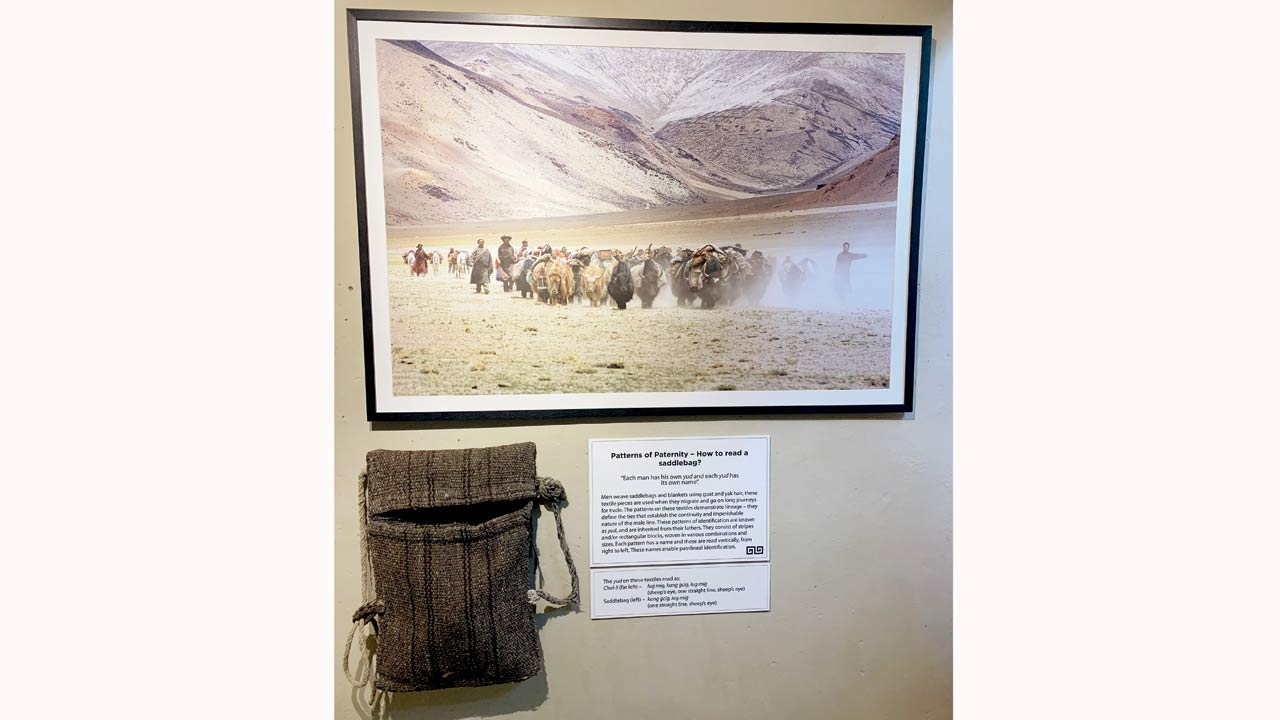 Patterns of Paternity – How to read a saddlebag? featured in Threads That Talk: Woven Narratives from Changthang at Ladakh Arts and Media Organisation, Leh. Each man weaves a unique “yud” made from goat and yak hair for saddlebags and blankets, symbolising lineage continuity, identified patrilineally by its distinct patterns read vertically right to left for identification
Patterns of Paternity – How to read a saddlebag? featured in Threads That Talk: Woven Narratives from Changthang at Ladakh Arts and Media Organisation, Leh. Each man weaves a unique “yud” made from goat and yak hair for saddlebags and blankets, symbolising lineage continuity, identified patrilineally by its distinct patterns read vertically right to left for identification
The saddlebag, made from goat and yak hair by men, features stripe and/or rectangular block patterns (known as ‘yud’) that enable patrilineal identification. Nearby, a giant backstrap loom (traditionally used by women in Changthang), made of wood, rope, string, and modern metal parts, rests as if impregnated with stories waiting to be told.
Threads That Talk fabricates a fuller and more complex understanding of how craft shapes a culture among the nomadic pastoralists of Eastern Ladakh, exploring themes of birth, spiritual and ceremonial ideals, gender, politics and family ties.
Woollen fabric not only expresses human existence, including childbirth, but also symbolises it: the tightly twisted warp signifies man, while the loosely woven weft represents the woman. Together, they bring new life into the world. Mumbai-based Ahmed, a textile anthropologist has spent the last 30 years researching the Changpa and is co-founder of LAMO. She likens weaving to meditation. “Buddhist spiritual metaphors permeate each part of the woman’s loom, and are woven into the very process. They portray their deep connections to spiritual beliefs and religious practices, where each act of weaving or part of the loom holds profound religious meaning. The entire process thus, is sacred, and underscores a continual engagement with what we understand as ‘religion’.”
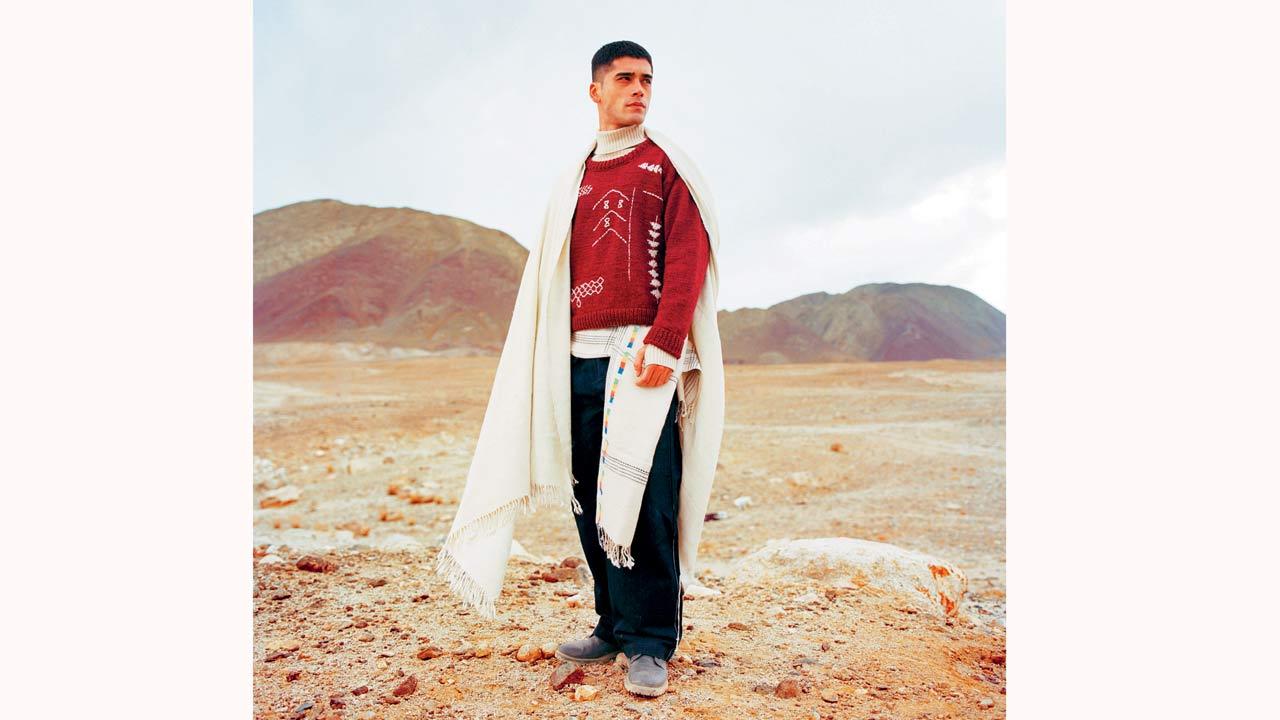 The Hanle sweater in burgundy and Korzok shawl are part of the sheep wool collection by Royal Enfield x Eka for Looms of Ladakh
The Hanle sweater in burgundy and Korzok shawl are part of the sheep wool collection by Royal Enfield x Eka for Looms of Ladakh
The exhibition unfolds in two parts: the first explores textile narratives from Eastern Changthang plateau, examining the origin of weaving, symbolism of the loom and livestock, and design metaphors linked to life, trade, and even tents, offering insights into social structure and gender roles. “Textiles encapsulate Ladakh’s rich cultural heritage, revealing narratives of almost every facet of life within a community, whether viewed collectively or through individual pieces,” Ahmed explains.
The second part, titled The Final Migration, showcases artworks by textile designer Divya Shree Dubey and a group of six women from Changthang. These narrative textiles recall childhood memories, the local landscape, objects of memories, personal challenges and aspirations, and document the transformative changes in Eastern Ladakh in recent years.
When considering the Ladakhi textile community’s national status, it is clear their recognition in terms of sales or visibility is relatively recent, gaining traction after 2010. “Unlike larger weaving centres like Varanasi, Ladakh faces unique challenges due to limited resources and manpower, which restrict its production capabilities. This results in a focus on small-scale, high-quality production rather than mass quantities,” explains Ahmed.
However, Ladakhi textiles are beginning to establish their presence in cities like New Delhi and Mumbai. Textile outfits such as Dastkar and Dilli Haat have stepped in, while fashion boutiques like Jigmat Couture are broadening the lexicon with a modern lens.
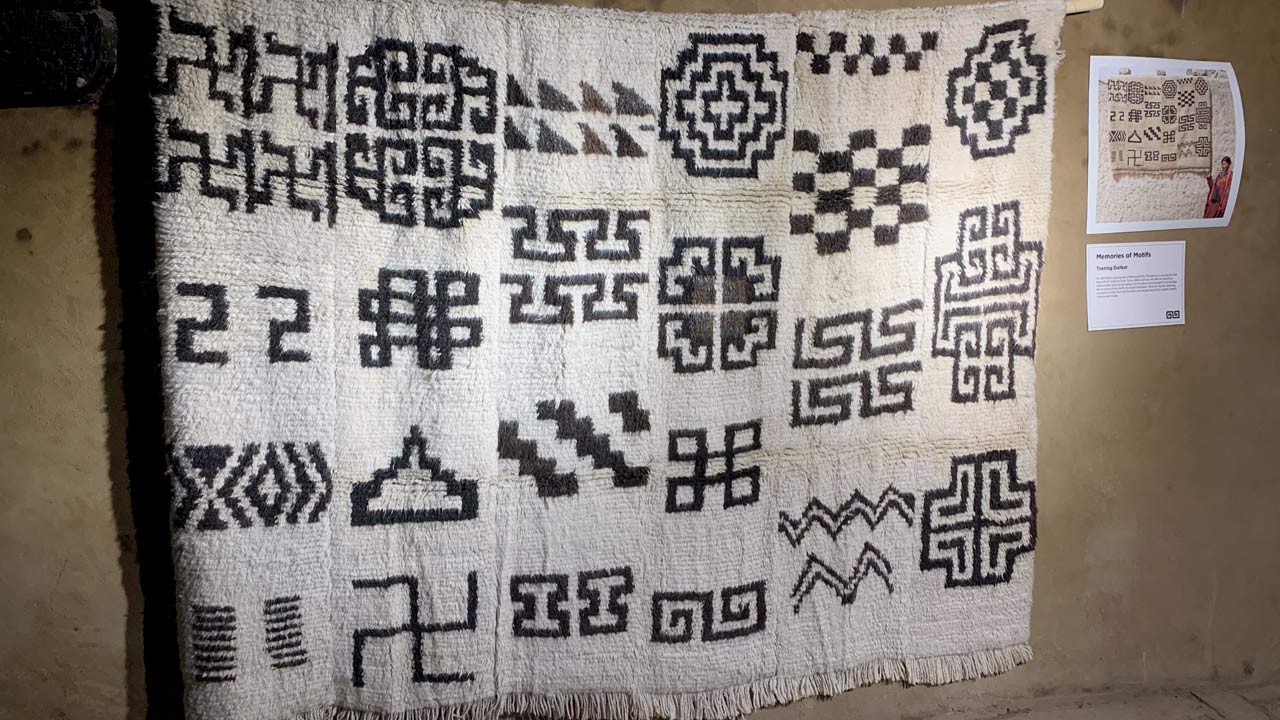 Memories of Motifs by Tsering Dolkar is part of Threads That Talk: Woven Narratives from Changthang. Abi (granny) Dolkar, a lifelong weaver, mastered Ladakhi motifs in her youth. Later, despite fading memory, she resumed weaving for this piece, intricately recreating those motifs as if she had never left the loom
Memories of Motifs by Tsering Dolkar is part of Threads That Talk: Woven Narratives from Changthang. Abi (granny) Dolkar, a lifelong weaver, mastered Ladakhi motifs in her youth. Later, despite fading memory, she resumed weaving for this piece, intricately recreating those motifs as if she had never left the loom
Additionally, The Himalayan Knot—a social mission project focused on textile conservation by India’s oldest motorcycle manufacturer, Royal Enfield—is contributing to this momentum. “Royal Enfield is not only helping develop and market new products but also investing in research and documentation. They are also supporting textile artistes through The Himalayan Knot residency, inaugurated this year with plans to make it annual,” adds Ahmed. “Ladakhi textiles have always been on a journey, what’s good to see is that this journey continues and the trajectory is growing.”
The Eka x Looms of Ladakh x Sheep Wool documentary, as part of The Himalayan Knot project, is a gentle, reflective film that quietly observes the slow process of wool production from sheep farming, shearing, scouring, carding, spinning to weaving and knitting, dyeing, finishing, and garment making.
The journey begins at Kharnak, situated 15,000 feet above sea level, continuing through Tanglang La Pass at 17,480 feet, passing Leh’s Women Empowerment Centre—an initiative by Looms of Ladakh and Indian Army—at 11,562 feet, moving through Stok Village at 11,473 feet, and following the Indus River at 13,779 feet to culminate at Eka Studio in New Delhi. Reflecting on the process, Rina Singh of Eka says: “The product, place and person had to come together.”
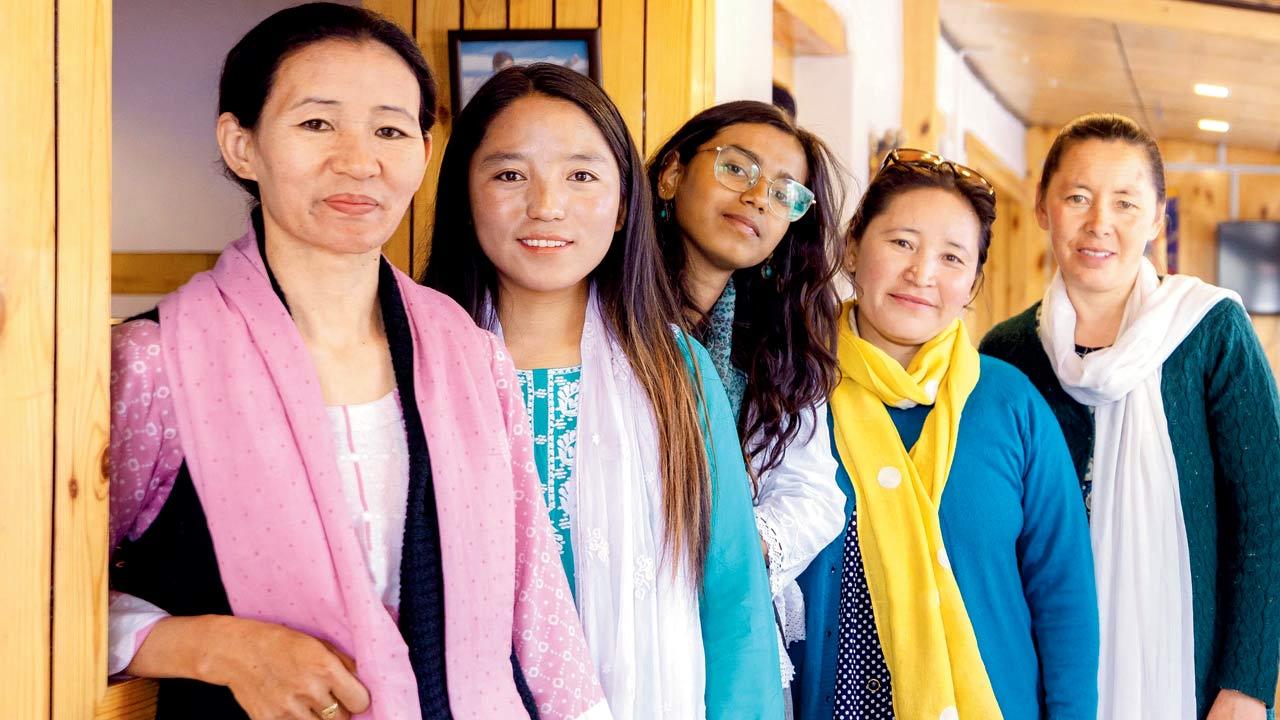 (Left to right) Lobzang Lamo, Padma Tashi and the Looms of Ladakh team
(Left to right) Lobzang Lamo, Padma Tashi and the Looms of Ladakh team
“The first successful embroidery design was mine!” Lobzang Lamo proudly declares about the mountain motif incorporated on a sweater by Singh. Lamo, 40, worked on this collaboration before concluding her tenure as CEO and design officer at Looms of Ladakh (LoL). Founded in 2017 by Abhilasha Bahuguna, LoL is an ethical, farm-to-fashion brand powered by over 400 herder-artisans across 20 villages.
Lamo, not your typical “MBA CEO”, studied till class 10 and was a homemaker before joining the founding team of LoL She is sharp as a tack. In contrast, Padma Tashi, 24, the newest team member, holds a BA degree. “As product manager, I oversee and distribute work, manage yarn inventory, set targets, ensure timely completion, and assess weavers’ capacities—all skills learned on the job,” Tashi says.
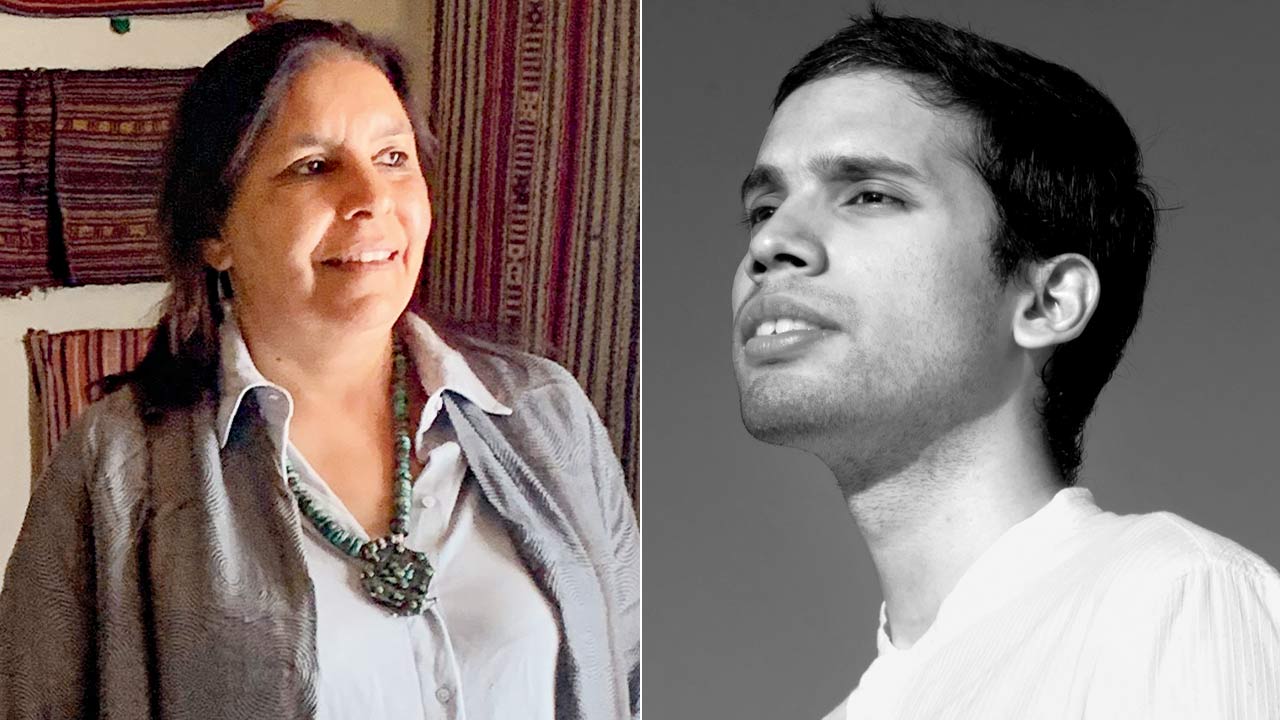 Monisha Ahmed and Nishant Raj
Monisha Ahmed and Nishant Raj
Traditionally, Ladakhis did not trade in textiles, especially those originating from within; everything was meant for domestic use. This meant no restriction on when and how items were made, unlike in business where timelines and customer understanding are crucial. “Working with Rina Singh on this project was an eye opener; it helped us understand the business and become more professional,” admits Nishant Raj, 32, design and production head at LoL. Originally from Orissa, Raj studied at National Institute of Design (NID) and National Institute of Fashion Technology (NIFT) before moving to Leh. His experience includes managing a Woolmark project and collaborating with artisan clusters in Kutch, Uttarakhand and Bengal.
Tashi, Lamo and Raj share a dream: to elevate LoL into a luxury fashion brand on par with top Indian and European labels. They aspire to see Ladakh benefit similarly to how Kashmir has from the pashmina trade. “Our goal is to create a comparable global identity for Ladakh.”
 Subscribe today by clicking the link and stay updated with the latest news!" Click here!
Subscribe today by clicking the link and stay updated with the latest news!" Click here!







